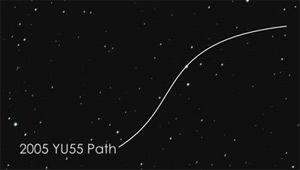The eyes of many astronomers – and the eyes of their telescopes – were aimed at the asteroid 2005 YU55 a few days ago, when it passed the Earth at the relatively close distance of about 320,000 km. One of those eyes was actually in space as well: NASA’s Swift satellite. This spacecraft was designed to look at the sky in the ultraviolet, X-ray, and gamma rays, all high-energy forms of light emitted by the most violent events in the universe: exploding stars and gamma-ray bursts.
But the Sun emits UV, and rock can reflect this light, too. So Swift observed YU55 as it passed us, and got this very interesting footage of it, what I think is the coolest I’ve seen so far:
[You can also watch it on YouTube if you prefer.]
Pretty neat, and by looking at the rock at different wavelengths, we can learn about its structure and composition, too.
But I know what you’re thinking: in the video, why did YU55 curve around as it moved? As it turns out, I was expecting this when I watched the video! What’s going on*?
 The asteroid is in elliptical orbit around the Sun, but over the short period of time covered by this video – about 20 minutes – it’s essentially moving in a straight line. The reason the path is all bendy is because Swift itself is in motion! Swift orbits the Earth, circling us once every 90 minutes or so. As it moves around us, its viewpoint is changing, and that motion is reflected in the asteroid.
Try this: look at some distant object like a mountain or tree, hold your thumb at arm’s length, close one eye, and then move your thumb to block the object. Now, holding your thumb still, move your head in a small circle. Even though your thumb isn’t moving (that may take practice!) it looks like it’s making a circle too. That’s because the angle between your eye, your thumb, and the distant object is changing as you move your head. This is called parallax, and I’ve explained this in an earlier post for a solar eclipse that had very similar circumstances as this Swift observation. I’ve written a general parallax description as well.
The asteroid is in elliptical orbit around the Sun, but over the short period of time covered by this video – about 20 minutes – it’s essentially moving in a straight line. The reason the path is all bendy is because Swift itself is in motion! Swift orbits the Earth, circling us once every 90 minutes or so. As it moves around us, its viewpoint is changing, and that motion is reflected in the asteroid.
Try this: look at some distant object like a mountain or tree, hold your thumb at arm’s length, close one eye, and then move your thumb to block the object. Now, holding your thumb still, move your head in a small circle. Even though your thumb isn’t moving (that may take practice!) it looks like it’s making a circle too. That’s because the angle between your eye, your thumb, and the distant object is changing as you move your head. This is called parallax, and I’ve explained this in an earlier post for a solar eclipse that had very similar circumstances as this Swift observation. I’ve written a general parallax description as well.
So the wiggly path of the asteroid is not from the asteroid, it’s from Swift itself! That’s pretty nifty. I’ll note the first time I saw this for myself was when a satellite called TRACE observed the transit of Venus across the Sun. I had to do the math to prove myself it was the satellite’s orbit making Venus move in a squiggly path, but it all worked out!
And there’s a lesson here: with astronomy, what you see is not always what you get. Pictures by themselves don’t tell you everything; you have to understand the instrument that took the picture. I spent years working on Hubble doing just this, trying to understand just how our camera on board the observatory was behaving. If you see two stars in the image and one looks brighter, how do you know the camera isn’t more sensitive where the brighter star happened to be? Or maybe that star is red, and the detector is more sensitive to red light. Or maybe the filter you used happens to let through light in a different way than you expected… or maybe it’s all three things!
Yeah, it’s complicated. And that’s why you always have to ask yourself, is what I’m seeing real? In this case, it is real, but not for the reason you expect. Feel free to extrapolate this to your own life in any way you see fit.
Credit: NASA
* Mark my words: someone will claim YU55 was under intelligent control. I can practically guarantee this. If you find a video or blog making that claim, please let me know!